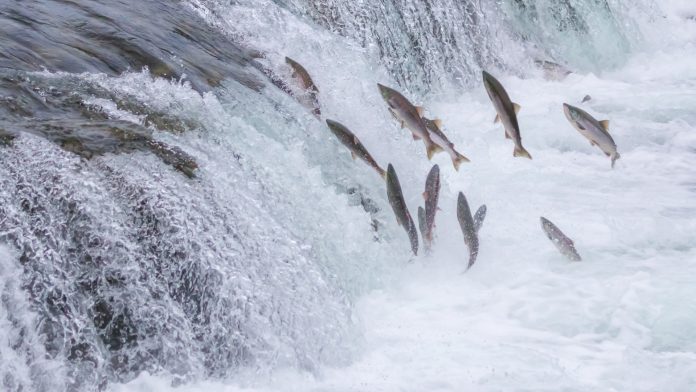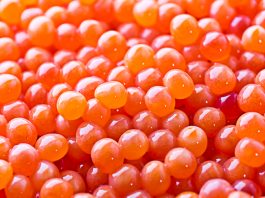Scientists committed a study, analysing the sensory mechanisms in salmon to understand exactly how magnetic perception works.
Magnetic perception
It’s widely understood in the scientific community that salmon, and even butterflies and birds, have an innate magnetic sense, which allows them to use the Earth’s magnetic field for navigation to places such as feeding and breeding grounds.
Bellinger’s work builds on research from more than 20 years ago by Michael Walker of the University of Auckland in New Zealand, who initially traced magnetic sensing to tissue in the noses of trout.
“He narrowed it down to magnetite in the olfactory rosette,” Renee Bellinger, PhD and lead author said: “We were expecting to see chains of crystals in the noses of salmon, similar to how magnetite-producing bacteria grow chains of crystals and use them as a compass needle. But it turns out the individual crystals are organised in compact clusters, like little eggs. The configuration was different than the original hypothesis.”
However, despite having this knowledge, researchers have failed to understand exactly how the underlying sensory mechanism for magnetic perception actually works. An international team of researchers, including scientists from Oregon State University (OSU), have introduced a new theory.
Salmon noses
Their paper was published in the journal Proceedings of the National Academy of Sciences and outlines their theory regarding magnetic perception. They propose that the magnetite crystals, which form inside specialised receptor cells of salmon and other animals, may have roots in ancient genetic systems that were developed by bacteria and passed to animals through evolution.
This is based on new evidence collected from nanoscopic material found within cells inhabiting salmon noses. Bellinger explained: “The cells that contain magnetic material are very scarce. We weren’t able to definitively prove magnetite as the underlying key to magnetic perception in animals, but our study revealed associated genes as an important tool to find new evidence of how potential magnetic sensors may function.
“Finding magnetic receptors is like trying to find a needle in haystack. This work paves the way to make the ‘needle’ glow really bright so we can find and understand receptor cells more easily.”
Michael Banks, a fisheries genomics, conservation and behaviour professor at OSU commented: “The findings have the potential for widespread application, from improving salmon management through better understanding of how they use the ocean to targeted medical treatments based on magnetism.
“Salmon live a hard and fast life, going out to the ocean to specific areas to feed and then coming back to their original spawning grounds where they die. They don’t have the opportunity to teach their offspring where to go, yet the offspring still somehow know where to go.
“If we can figure out the way animals such as salmon sense and orient, there’s a lot of potential applications for helping to preserve the species, but also for human applications such as medicine or other orientation technology.”
Evolutionary component
“The form in which magnetite appears, as tiny crystals inside specialized receptor cells, represents biomineralisation, or the process by which living organisms produce minerals. The similarity between magnetite crystals of bacteria and fish suggests that they share a common evolutionary genetic history,” Bellinger said.
Banks added: “The mechanism for developing magnets was developed by bacteria more than two billion years ago and then passed on to animals. Today, these tools to perceive magnetism continue to be present across a broad array of animal species.
“The process for sharing them across animal life may have been similar to the evolution of mitochondria, which control how animals release energy. Mitochondria originated in bacteria and were then transferred to other organisms.”
“Understanding the evolutionary history of magnetite is a step toward further pinpointing the underlying process,” the researchers concluded. Banks, Bellinger and colleagues aim to next test their new understanding and associated markers to further address the mystery of why and how some life forms have well-tuned tools for long and precise migratory strategies.








